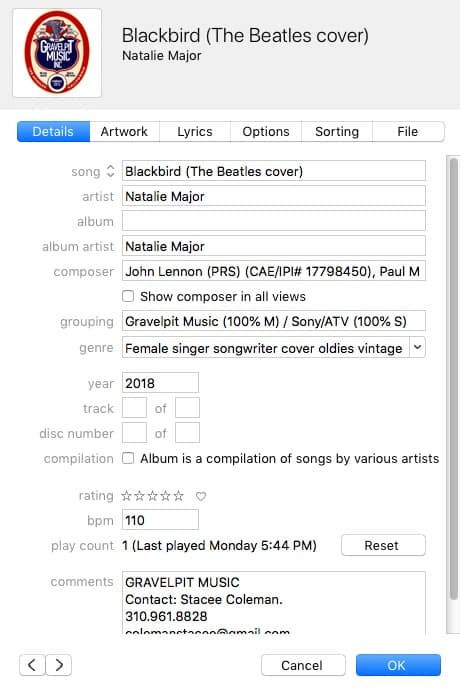This blog post comes courtesy of Laura Katz, Guild of Music Supervisors member and founder of music supervision company Supe Troop.
We get in so much music every day! While that’s actually one of the best things about this job, it’s also a bit of a curse if we don’t get the right information upfront. I can’t count how many times we’ve really loved a song for a spot, but we couldn’t pitch it to the director because we couldn’t figure out who sent it to us or who owned it. Assuming you don’t want that to happen to your music, here are some guidelines to make sure we can use your music. Help us help you!
The Guild of Music Supervisors recommends that as much information as possible be included in the metadata of all digital music submissions, with underlined content being required.
I. Song Name –
A. Any featured artist on a song should be included in the song name: “Song Title (feat. Guest Artist)”
B. If a song is a cover, cite that in the Song Name field as “Song Name (Original artist cover)”
C. Example: “Big Yellow Taxi (Joni Mitchell cover)”
II. Artist – Artist name
III. Composer – First name Last name – (Ownership %) (PRO#) / repeat as many times as needed
A. Info should be filled out with full names, PRO information (and CAE/IPI# wherever possible), and splits.
B. If it’s a public domain song, start by saying “Public Domain” so that people can sort by the Composer field and all the public domain songs will show up together (i.e. Public Domain – First name Last name)
IV. Year – Should be the year the master was originally released. In cases where a previously unreleased song is recorded decades before, defer to the recording year.
V. Genre – Include if you have it, but not required
VI. BPM – Include if you have it (very helpful), but not required
VII. Rating – Do NOT include rating. Have this empty so music supervisors can use it themselves if they want.
VIII. Grouping – Company clearing the master side (% controlled M) / Company clearing pub side (% controlled S)
A. Include who is sending the song and the percent they control of a certain side (i.e. UMPG (45% S)).
B. If the sender has the song one-stop, it would say so here, as well. (i.e. Bank Robber Music (one-stop)).
C. The Grouping section includes the company that is the contact the music supervisor is dealing with, not the actual cue sheet publisher name (if they differ).
IX. Comments – Contact info for licensing party. Also include “consult about territories” here if you have issues regarding territories (i.e. you are able to clear worldwide but only if the license will be paid out of the U.S.A., or if you can only clear for specific territories)
X. Album – Album name
XI. Album Artist – Same as Artist above, or nothing
XII. Disc Number – Include if you have it, not required
XIII. Track – Include if you have it, not required
XIV. Artwork – Include if you have it, not required
Some examples of correct metadata tagging:
1. One-Stop song:
2. Master of a Public Domain song:

3. Cover pitched by Master representative:
Please note: the companies mentioned in the metadata text are not connected to this post


6 comments
Very Useful info
The info you all give us is priceless. Thank you SyncTank
Is there a reason you don’t include ISRC codes for the recording? Would certainly help make sure the correct recording is identified.
As far as I’m concerned, crowding-up the composer field with composite metadata such as “full names, PRO information, CAE/IPI# and ownership splits” is a wonderful example of going against the notion of standards.
Laura you are a LEGEND. Have been looking for the metadata explanation with images for ages. Super helpful, thank you!
[…] Guild of Music Supervisors Metadata Standards […]